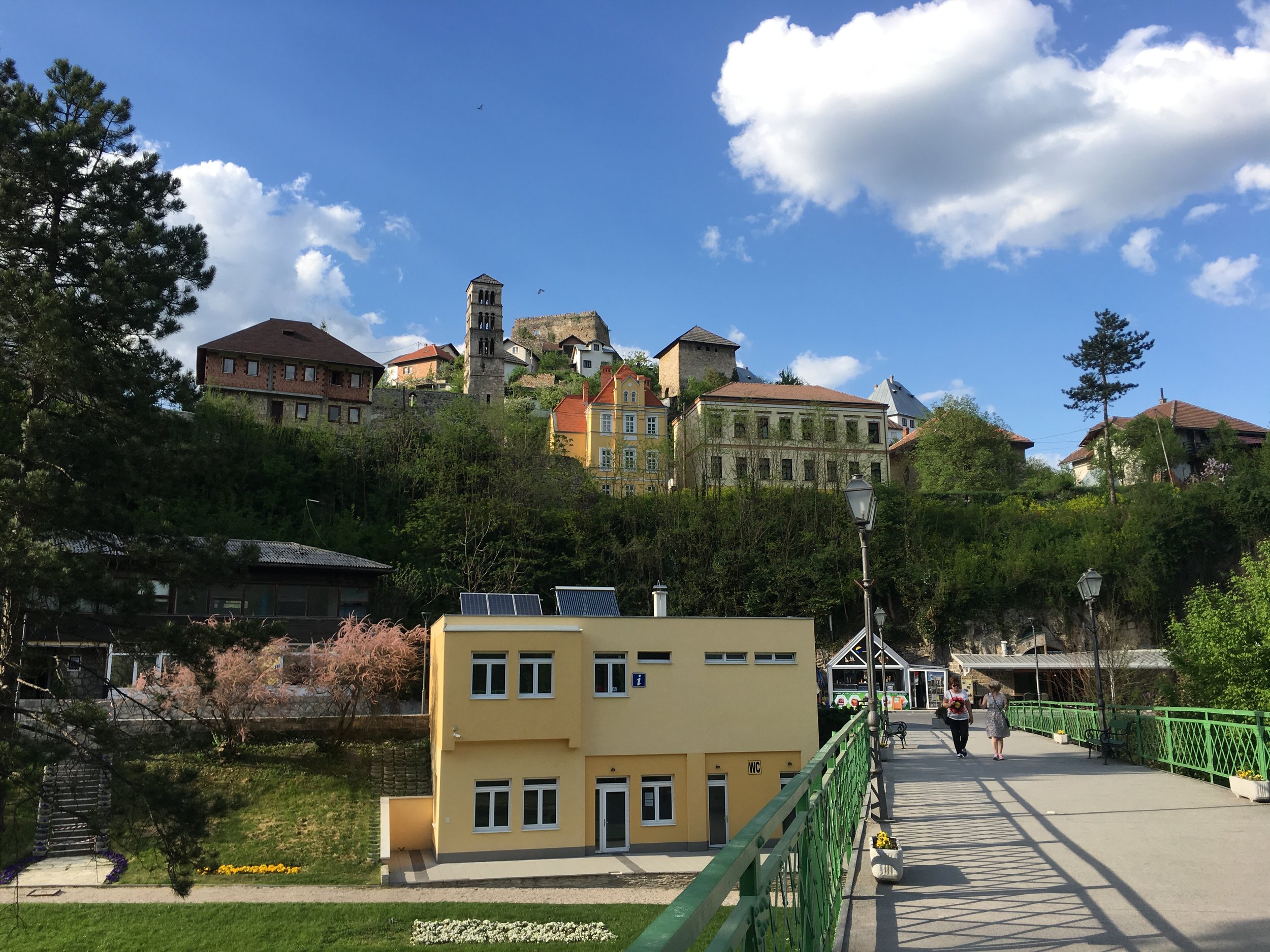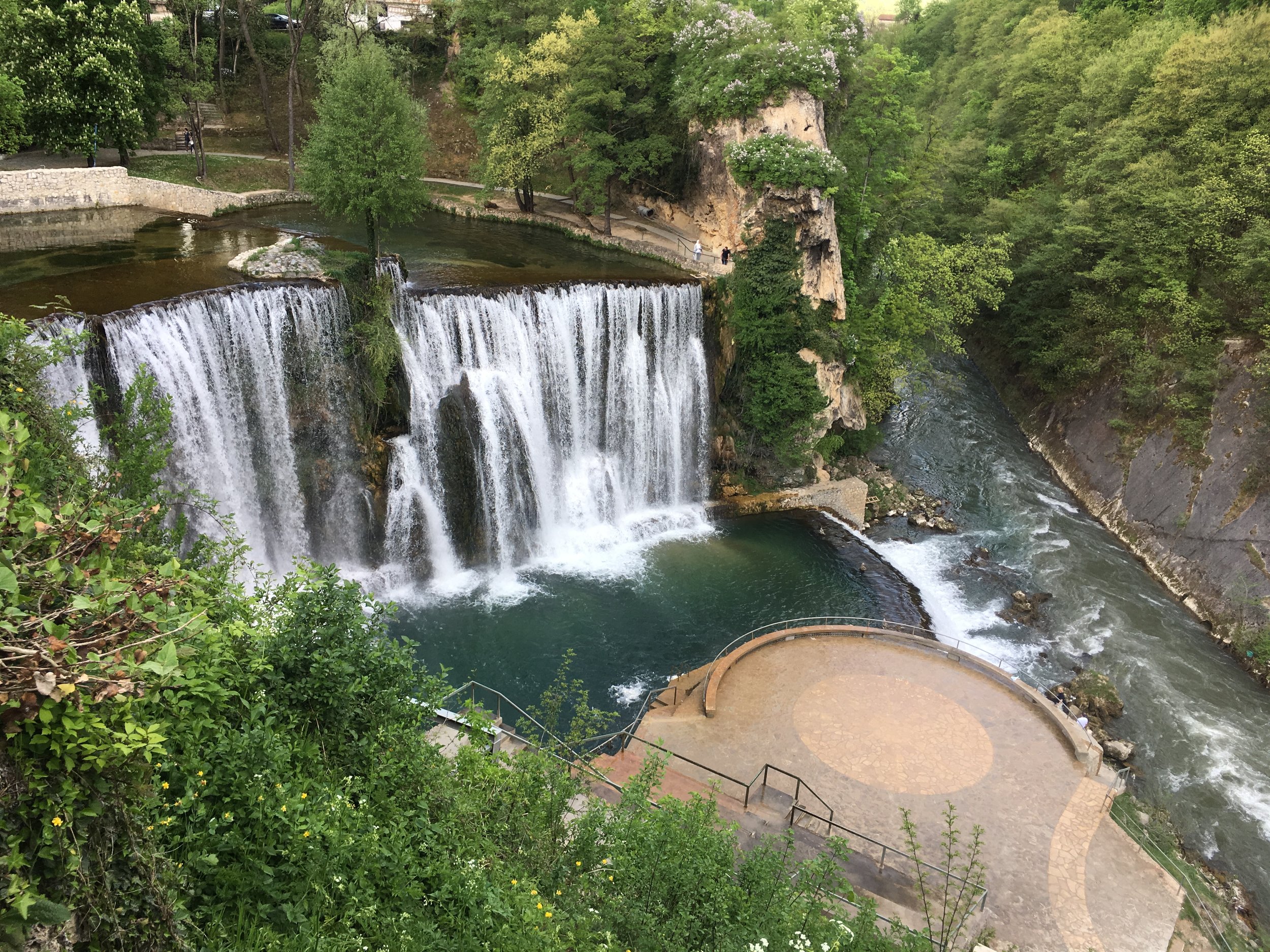JAJCE
© John Bills
Jajce is the most beautiful town in Bosnia and Herzegovina. How could it not be? It is surrounded by lakes and mountains, has a delightful and significant old town and fortress, and the small matter of waterfalls at its heart. I’m not talking ‘sputtering river’ either; these are fully-grown waterfalls, cascades that give Jajce its purpose and meaning. The town is important besides waterfalls, being the location of the Last King of Bosnia’s execution and all that, but the Pliva Waterfall dominates life here today.
Simply put, if you are buying a magnet or postcard, it will have the waterfalls front and centre. Unsurprisingly, for a place of such beauty, Jajce has been the HQ of choice for kings, governors and rulers of all shapes, sizes and states. It was the last town to fall to the Ottomans, home to the second AVNOJ meeting, and where you’ll find the best pub in Bosnia and Herzegovina. Sure, it needs better hotels and restaurants, but let’s not bother with the negatives. After all, it has those waterfalls…
TRANSPORT
© John Bills
Jajce bus station (Drugog zasjedanja AVNOJ-a, +387 30 658 047) is so close to being one of the best in the country. The ticket office is simple, and the staff are friendly, maybe even the friendliest in the country. There is a little shop for snacks, and the toilets are always open and relatively clean. The location could be better (a short walk from the town), but you get to walk past the waterfalls on your way, negating any complaints there. Cafe? There is a cafe, but it doubles up as a betting shop, and I don’t know if I’m particularly thrilled about singing their praises. There is something jarring about seeing middle-aged men gambling and drinking at 9 in the morning, although it is best not to judge. The staff are pretty lazy, so good luck getting served. Still, this is one of the better bus stations in Bosnia and Herzegovina. Daily buses run to Sarajevo, Banja Luka, Travnik, Tuzla, Zenica, Bihać and many others.
WHAT TO SEE AND DO
© John Bills
Pliva Waterfall
In the Hall of Fame of Bosnia and Herzegovina views, the Pliva Waterfall is a first ballot entry. Jajce is a special place; much of its eminence is derived from the 24-metre waterfall that shimmers in its heart. It used to be 30 metres, but a combination of earthquakes and bombing reduced the size. You won’t miss those six metres, I promise you. Jajce’s famous waterfalls are one of the great attractions of BiH, the very definition of a must-see, and the glittering jewel around which a gorgeous town spreads. Stunning.
© WikiMedia Commons
Jajce Fortress
Bosnia and Herzegovina is a strange place at the best of times, a magical place where stunning images are juxtaposed against tumultuous events. Jajce Fortress is another excellent example. It is the cherry on top of this city’s delicious cake, the pinnacle of a town worth savouring, one of the best preserved Bosnian fortresses and a reminder of when Bosnia was at its political peak. On the other side of the coin, the fortress represents the end of Bosnian sovereignty, as it was the last fortress to fall to the Ottomans, doing so in 1527. This 14th-century marvel witnessed many important events before that, with many regional powers striving to conquer it from beginning to end. Tourists have conquered it today, of course, so join the throngs and enjoy the views. Harmani, +387 30 659 888
© John Bills
Catacombs
There isn’t a massive amount to see in Jajce’s catacombs, but it is an underground crypt in a small central town, so I’m not sure what to tell you. What is there is definitely worth seeking out, as the crypt is the final resting place of Hrvoje Vukčić Hrvatinić, the medieval founder of Jajce who was a significant player in Bosnian politics at the time. The catacombs are just under the fortress, next to the Bear Tower, so nip into them before continuing the climb. Be sure to pick up some handcrafted wood souvenirs from the house opposite, and maybe even stop for a coffee to hear about the family’s long history in that very dwelling. Svetog Luke
© marketa1982 // Shutterstock.com
Mlinčići
Jajce is a fairytale playground from an aesthetic point of view. Just outside the town are the Pliva Lakes, best known for the quaint mills that dot the water. The lakes are the largest natural lakes in the country, reason enough for visiting, but you aren’t here for figures. You are here for the gorgeous views, the shimmering cerulean water, the adventures found out there, and the serene stories told in whispers by those mills. Constructed in the 16th century (1562, to be exact), the mills are located between the big and small lakes and hark back to a time of harmony between humans and nature. That is assumptive of me, of course, but the mind tends to wander in a place like this.
© John Bills
Museum of the 2nd AVNOJ Session
There are several AVNOJ museums dotted around Bosnia and Herzegovina, but Jajce’s is arguably the best. Located in the building where the second AVNOJ session occurred, the museum outlines each republic’s role in the struggle to liberate Yugoslavia, with artefacts and information all around. The museum shop is also a little charmer, with badges and pins from all over the region, not to mention all the Tito regalia you could ever ask for. Drugog zasjedanja AVNOJ-a, +387 30 657 998
© marketa1982 // Shutterstock.com
Church of St John in Podmilačje
The extravagant architecture of the newly-constructed church in Podmilačje might grab the attention, but move your focus to its more understated neighbour for the important stuff. The Church of St John the Baptist was constructed in the 15th century, the work of Gothic Dalmatian masters, although nobody is 100% sure about that. It continued to function during the Ottoman centuries, working as a multiconfessional space visited by pilgrims from all over the region, no matter their faith. It was thought to have been the only medieval church in Bosnia to remain open that entire time. Of course, it was thus destroyed in the most recent war but has since been rebuilt. Masses of people head this way on St John’s Eve (June 23/24), pilgrims looking for answers, cures to ailments, or peace.
© John Bills
Ethnographic Museum
Jajce’s Ethnographic Museum is another fascinating spot on the hill in the town centre, taking visitors on a ride through the centuries of culture and tradition in these parts. The geological and mineralogical exhibit is extensive, but the interest ramps up in the 19th and 20th centuries with a curious collection of photos and postcards from years ago. The building is an architectural gem; it used to be Jajce’s primary school. The ruins of St Mary’s Church and the magnificent St Luke’s Bell Tower are next door. Svetog Luke 15, +387 30 658 268
© John Bills
Omer Bey’s House
What a gorgeous setting for a home. Jajce’s Omer Bey House sits calmly above the main entrance to town, a fairly standard example of Ottoman-era Bosnian residential architecture constructed at some point in the 17th century. It passed through many hands over the years and functioned as a restaurant in the 20th century, although it then fell into disrepair. Extensive work has seen it renovated once more, although it is still at the mercy of the elements. There is often talk of turning it into a museum, but that remains a plan and not a reality. Hrvoje Vukčića Hrvatinića
© John Bills
Franciscan Friary
Back in the medieval days, the Franciscans went about their merry business in Central Bosnia, and their legacy is seen all over through the many marvellous monasteries that remain. Jajce’s Franciscan Friary was established in 1885, redesigned in the 20th century by Karel Pařík and today, it houses a museum telling the tale of its storied history, along with showcases of art and other artefacts. Fra Antuna Kneževića
BREWS, BOOZE AND BITES
© John Bills
Svemirko first, Svemirko second, Svemirko forever. Svemirko Pub (Maršala Tita 51, +387 30 332 008) has a great story, great beer, fantastic owners, great food, everything great, great, great. It isn’t hard to find either, so stop complaining. Just head to the birthplace of Nikola Šop and get sipping on a Gorštak. Cheers Pub (ZAVNOBIH-a, +387 63 844 205) has decent beer-drinking conditions, friendly service and live sports. It isn’t going to blow you away, but not every pub has to be the best pub ever, obviously. It ticks the box. That is the best way to describe the city's cafes; everywhere is fine. Where to recommend? Galerija, I suppose. It's best to see if you can get a coffee in the house opposite the Catacombs with the friendly owner. Despite being one of the most exciting and beautiful cities in Bosnia and Herzegovina, Jajce is shockingly underdeveloped on the restaurant front. Sure, there is the usual range of ćevabdžinicas and pizzerias, but nowhere stands out. If you have wheels, head to Hotel Plivsko Jezero (Mile bb, +387 30 654 090) for good food and gorgeous views.
SLEEPING
© John Bills
As with the restaurants above, Jajce could be better on the accommodation front. Hotel Turist (Kulina Bana, +387 30 658 151) is in the town centre and ticks some boxes, with friendly staff and large rooms (and complicated showers), but the wi-fi was wretched, and it was a little overpriced. Jajce Youth Hostel (Kralja Stjepana Tomaševića, +387 63 262 168) is a cheap and cheerful option for the budget-conscious and dorm-happy traveller. Hotel Plivsko Jezero (Mile bb, +387 30 654 090) is excellent, albeit 6km out of town. You get to stay on the lake (as the name suggests), which makes up for all that distance.












